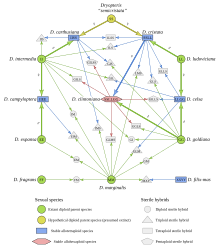North American Dryopteris hybrid complex: Difference between revisions
Content deleted Content added
Emilysessa (talk | contribs) m Fixed title to be more accurate |
Emilysessa (talk | contribs) Updated descriptive text, renamed headings to be more informative, added reticulogram figure, added a hybrid to the list of "other hybrids" |
||
| Line 1: | Line 1: | ||
{{DISPLAYTITLE: North American''Dryopteris'' hybrid complex}} |
{{DISPLAYTITLE: North American''Dryopteris'' hybrid complex}} |
||
[[File:North American Dryopteris reticulogram.svg|alt=North American Dryopteris reticulate complex|thumb|North American ''Dryopteris'' reticulate complex]] |
|||
[[Hybridization (biology)|Hybridization]] and [[polyploidy]] are common phenomena in [[Fern|ferns]], and the genus ''[[Dryopteris]]'' is known to be one of the most freely-hybridizing fern genera<ref>{{Cite journal|last=Sessa|first=Emily B.|last2=Zhang|first2=Li-Bing|last3=Väre|first3=Henry|last4=Juslén|first4=Aino|date=2015-08-01|title=What We Do (and Don't) Know About Ferns: Dryopteris (Dryopteridaceae) as a Case Study|url=http://openurl.ingenta.com/content/xref?genre=article&issn=0363-6445&volume=40&issue=2&spage=387|journal=Systematic Botany|language=en|volume=40|issue=2|pages=387–399|doi=10.1600/036364415X688844}}</ref>. [[North America|North American]] botanists recognized early on that there were close relationships between many of the species of ''[[Dryopteris]]'' on the continent, and that these relationships reflected hybrid ancestry<ref>{{Cite book|title=Flora of North America North of Mexico, vol. 2|last=Montgomery|first=J|last2=Wagner|first2=WH|publisher=Oxford University Press|year=1993|isbn=|location=New York, New York|pages=}}</ref>. The complex includes five sexual [[Ploidy|diploid]] parents (one of which, "''D. semicristata"'', is hypothesized to be extinct<ref>{{Cite journal|last=Sessa|first=Emily B|last2=Zimmer|first2=Elizabeth A|last3=Givnish|first3=Thomas J|date=2012|title=Unraveling reticulate evolution in North American Dryopteris (Dryopteridaceae)|url=http://bmcevolbiol.biomedcentral.com/articles/10.1186/1471-2148-12-104|journal=BMC Evolutionary Biology|language=en|volume=12|issue=1|pages=104|doi=10.1186/1471-2148-12-104|issn=1471-2148|pmc=PMC3509404|pmid=22748145}}</ref>), six sexual tetraploids, and numerous sterile hybrids at various ploidal levels. |
|||
| ⚫ | |||
The fern genus ''[[Dryopteris]]'' is known to be one of the most freely-hybridizing of fern genera. |
|||
| ⚫ | |||
| ⚫ | |||
*''[[Dryopteris expansa]]'' |
*''[[Dryopteris expansa]]'' |
||
*''[[Dryopteris goldieana]]'' |
*''[[Dryopteris goldieana]]'' |
||
| ⚫ | |||
*''[[Dryopteris ludoviciana]]'' |
*''[[Dryopteris ludoviciana]]'' |
||
*''[[Dryopteris marginalis]]'' |
*''[[Dryopteris marginalis]]'' |
||
*''Dryopteris "semicristata"'' |
|||
== |
==Polyploid species== |
||
*''[[Dryopteris carthusiana]]'' (''D. intermedia'' × |
*''[[Dryopteris carthusiana]]'' (''D. intermedia'' × ''"D. semicristata"''; allotetraploid) |
||
*''[[Dryopteris campyloptera]]'' (''D. intermedia'' × ''D. expansa''; allotetraploid) |
*''[[Dryopteris campyloptera]]'' (''D. intermedia'' × ''D. expansa''; allotetraploid) |
||
*''[[Dryopteris celsa]]'' (''D. goldieana'' × ''D. ludoviciana''; allotetraploid) |
*''[[Dryopteris celsa]]'' (''D. goldieana'' × ''D. ludoviciana''; allotetraploid) |
||
*''[[Dryopteris clintoniana]]'' (''D. cristata'' × ''D. goldieana''; |
*''[[Dryopteris clintoniana]]'' (''D. cristata'' × ''D. goldieana''; allohexaploid) |
||
*''[[Dryopteris cristata]]'' (''D. goldieana'' × |
*''[[Dryopteris cristata]]'' (''D. goldieana'' × ''"D. semicristata"''; allotetraploid) |
||
*''[[Dryopteris filix-mas]]'' (progenitors unknown) |
|||
==Other hybrids== |
==Other hybrids== |
||
*''Dryopteris × australis (D. celsa × D. ludoviciana; [[triploid]])'' |
|||
*''Dryopteris'' × ''bootii'' (''D. cristata'' × ''D. intermedia''; [[triploid]]) |
*''Dryopteris'' × ''bootii'' (''D. cristata'' × ''D. intermedia''; [[triploid]]) |
||
*''Dryopteris'' × ''critica'' (''D. borreri'' × ''D. filix-mas'')<ref name=murphy>{{cite book |last1=Murphy |first1=Rosaline J. |last2=Page |first2=Christopher N. |author2link=Christopher Nigel Page |last3=Parslow |first3=Rosemary E. |last4=Bennallick |first4=Ian J. |date=2012 |title=Ferns, Clubmosses, Quillworts and Horsetails of Cornwall and the Isles of Scilly |location=Truro |publisher=ERCCIS |isbn=978-1-902864-07-5}}</ref> |
*''Dryopteris'' × ''critica'' (''D. borreri'' × ''D. filix-mas'')<ref name=murphy>{{cite book |last1=Murphy |first1=Rosaline J. |last2=Page |first2=Christopher N. |author2link=Christopher Nigel Page |last3=Parslow |first3=Rosemary E. |last4=Bennallick |first4=Ian J. |date=2012 |title=Ferns, Clubmosses, Quillworts and Horsetails of Cornwall and the Isles of Scilly |location=Truro |publisher=ERCCIS |isbn=978-1-902864-07-5}}</ref> |
||
Revision as of 15:32, 5 September 2019

Hybridization and polyploidy are common phenomena in ferns, and the genus Dryopteris is known to be one of the most freely-hybridizing fern genera[1]. North American botanists recognized early on that there were close relationships between many of the species of Dryopteris on the continent, and that these relationships reflected hybrid ancestry[2]. The complex includes five sexual diploid parents (one of which, "D. semicristata", is hypothesized to be extinct[3]), six sexual tetraploids, and numerous sterile hybrids at various ploidal levels.
Diploid species
- Dryopteris intermedia
- Dryopteris expansa
- Dryopteris goldieana
- Dryopteris ludoviciana
- Dryopteris marginalis
- Dryopteris "semicristata"
Polyploid species
- Dryopteris carthusiana (D. intermedia × "D. semicristata"; allotetraploid)
- Dryopteris campyloptera (D. intermedia × D. expansa; allotetraploid)
- Dryopteris celsa (D. goldieana × D. ludoviciana; allotetraploid)
- Dryopteris clintoniana (D. cristata × D. goldieana; allohexaploid)
- Dryopteris cristata (D. goldieana × "D. semicristata"; allotetraploid)
- Dryopteris filix-mas (progenitors unknown)
Other hybrids
- Dryopteris × australis (D. celsa × D. ludoviciana; triploid)
- Dryopteris × bootii (D. cristata × D. intermedia; triploid)
- Dryopteris × critica (D. borreri × D. filix-mas)[4]
- Dryopteris × complexa aggregate (D. filix-mas and D. affinis; tetraploid)[4]
- Dryopteris × convoluta (D. cambrensis × D. filix-mas)[4]
- Dryopteris × deweveri (D. dilatata × D. carthusiana)[4]
- Dryopteris × neo-wherryi (D. goldieana × D. marginalis; diploid)
- Dryopteris × triploidea (D. carthusiana × D. intermedia; triploid)
References
- ^ Sessa, Emily B.; Zhang, Li-Bing; Väre, Henry; Juslén, Aino (2015-08-01). "What We Do (and Don't) Know About Ferns: Dryopteris (Dryopteridaceae) as a Case Study". Systematic Botany. 40 (2): 387–399. doi:10.1600/036364415X688844.
- ^ Montgomery, J; Wagner, WH (1993). Flora of North America North of Mexico, vol. 2. New York, New York: Oxford University Press.
- ^ Sessa, Emily B; Zimmer, Elizabeth A; Givnish, Thomas J (2012). "Unraveling reticulate evolution in North American Dryopteris (Dryopteridaceae)". BMC Evolutionary Biology. 12 (1): 104. doi:10.1186/1471-2148-12-104. ISSN 1471-2148. PMC 3509404. PMID 22748145.
{{cite journal}}: CS1 maint: PMC format (link) CS1 maint: unflagged free DOI (link) - ^ a b c d Murphy, Rosaline J.; Page, Christopher N.; Parslow, Rosemary E.; Bennallick, Ian J. (2012). Ferns, Clubmosses, Quillworts and Horsetails of Cornwall and the Isles of Scilly. Truro: ERCCIS. ISBN 978-1-902864-07-5.
